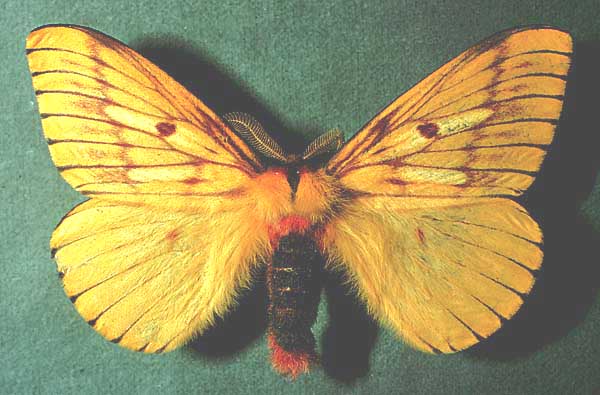Xanthodirphia amarilla
zan-thoh-DIRF-ee-uhMagh-muh-RIL-luh
Schaus, 1908

Xanthodirphia amarilla courtesy of Dan Janzen.
TAXONOMY:Superfamily: Bombycoidea, Latreille, 1802 |
"Someone to Watch |
|
|
Updated as per Lemaire's Hemileucina 2002, November 23, 2005 Updated as per http://www.inbio.ac.cr/bims/k02/p05/c029/o0119/f00885.htm IB, April 2008 Updated as per personal communication with Vernon Brou, 2900m; August 17, 2012 |

TAXONOMY:Superfamily: Bombycoidea, Latreille, 1802 |
"Someone to Watch |

Xanthodirphia amarilla male, Costa Rica,
2900m, courtesy of Vernon A. Brou.
Adults are on the wing in all months, except perhaps March.
Males come in to lights readily, but females are seldom taken at lights.

Xanthodirphia amarilla female, Costa Rica, courtesy of Dan Janzen.
Xanthodirphia amarilla larvae are probably gregarious and probably have the urticating spines typical of larvae from the Subfamily Hemileucinae.
Return to Xanthodirphia Genus
Return to Mexican and Central American Saturniidae Directory
Return to Main WLSS Index
The pronunciation of scientific names is
troublesome for many. The "suggestion" at the top of the page is
merely a suggestion. It is based on commonly
accepted English pronunciation of Greek names and/or some
fairly well accepted "rules" for latinized scientific names.
The suggested pronunciations, on this page and on other pages,
are primarily put forward to assist those who hear with internal
ears as they read.
There are many collectors from different countries whose
intonations and accents would be different.
Some of the early describers/namers chose genus
and species names indicating some character of the insect, but more
often, they simply chose names from Greek or Roman mythology or
history. Those species names which end in "ensis" indicate a
specimen locale, and those which end in "i", pronounced "eye", honour
a contempory friend/collector/etc.
I do not know the source of the genus
name "Xanthodirphia" chosen by Michener in 1949, but he probably
saw similarities to the genus "Dirphia" chosen by Hubner in 1819.
The first member of the genus was the yellow moth
Xanthodirphia amarilla and 'xantho' is the Greek word for
yellow.
The species name "amarilla" is the Spanish name for yellow.
This page is designed and maintained by Bill Oehlke as part of the World's Largest Saturniidae Site.